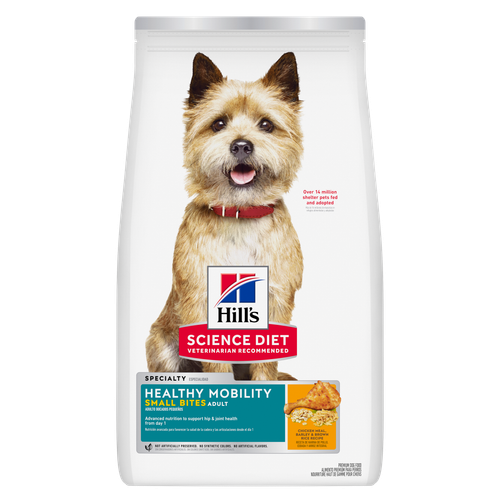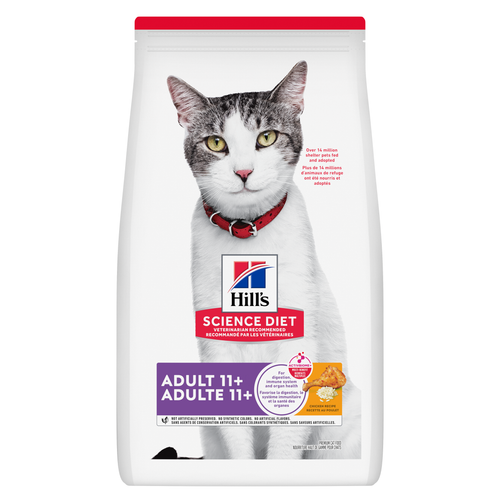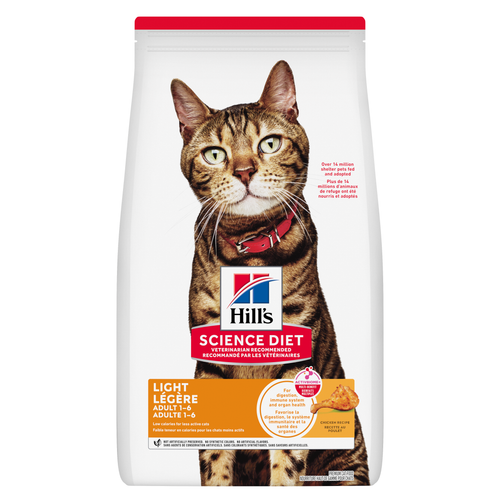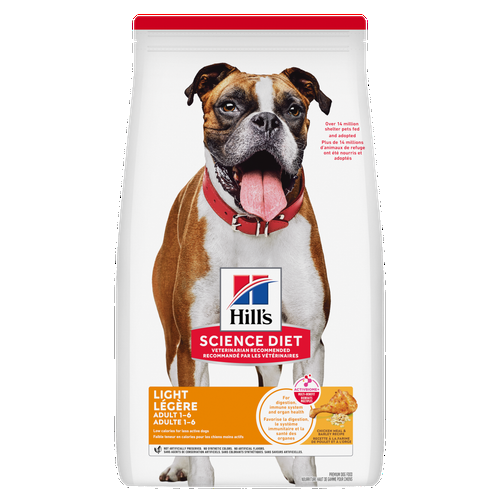
-
Find the right food for your petTake this quiz to see which food may be the best for your furry friend.Find the right food for your petTake this quiz to see which food may be the best for your furry friend.Featured products
 Adult Sensitive Stomach & Skin Small & Mini Chicken Recipe Dog Food
Adult Sensitive Stomach & Skin Small & Mini Chicken Recipe Dog FoodHill's Science Diet Sensitive Stomach & Skin Small & Mini dry dog food is tailored nutrition for Small & Mini dogs while being gentle on stomachs. Nourishes skin & promotes a lustrous coat.
Shop Now Adult Healthy Mobility Small Bites Chicken Meal, Barley & Brown Rice Recipe Dog Food
Adult Healthy Mobility Small Bites Chicken Meal, Barley & Brown Rice Recipe Dog FoodAdvanced nutrition to support hip & joint health from day 1
Shop Now Adult Light Large Breed Chicken Meal & Barley Recipe Dog Food
Adult Light Large Breed Chicken Meal & Barley Recipe Dog Food18% lower calories vs. Science Diet Large Breed Adult
Shop NowFeatured products Adult Healthy Cuisine Seared Tuna & Carrot Medley Cat Food
Adult Healthy Cuisine Seared Tuna & Carrot Medley Cat FoodDelicious seared tuna paired with tender carrots in a mouthwatering sauce
Shop Now Adult 11+ Chicken Recipe Cat Food
Adult 11+ Chicken Recipe Cat FoodSupports brain health & beautiful fur. Helps keep immune system, heart & kidneys healthy.
Shop Now Adult Light Chicken Recipe Cat Food
Adult Light Chicken Recipe Cat Food20% lower calories vs. Hill's Science Diet Adult
Shop Now -
Dog
- Dog Tips & Articles
-
Health Category
- Weight
- Food & Environmental Sensitivities
- Urinary
- Digestive
- Joint
- Kidney
- Dental
- Cancer
-
Life Stage
- Puppy Nutrition
- Adult Nutrition
- Senior Nutrition
Cat- Cat Tips & Articles
-
Health Category
- Weight
- Skin & Food Sensitivities
- Urinary
- Digestive
- Kidney
- Dental
- Stress
- Cancer
-
Life Stage
- Kitten Nutrition
- Adult Nutrition
Featured articles Importance of DHA in your Pet's Food
Importance of DHA in your Pet's FoodLearn about DHA, Docosahexaenoic Acid, a natural omega-3 fatty acid that is essential in the development of the brain and nervous system in cats & dogs.
Read More Antioxidants
AntioxidantsUnderstand the importance of antioxidants in your dog or cat's food, and how they can help protect your pet and keep them healthy.
Read More Water
WaterDiscover why water is the most important nutrient for your dog or cat to live a healthy life. Find out how much water your pet should consume each day.
Read More -


When summer arrives, you may find more dogs swimming happily at the beach, playing in kiddie pools or even frolicking near a sprinkler. If you're thinking, "My dog is afraid of water; they would never do that," you're not alone. Some pet parents may not even know how to bathe a dog who is afraid of water, let alone encourage them to swim. Use this guide to help you understand how to get your dog feeling safe around water.
Why Are Some Dogs Afraid of Water?
There are many reasons why dogs may be fearful of water. It could simply be that it's a new experience for them or that the water feels different under their paws or on their fur. Your pet may have also had a traumatic experience with water. Or, maybe they were forced to get wet when they weren't ready. If you're thinking your dog is afraid of water but don't know how to help, the first step is simply helping your dog unlearn any negative water connotations. Then, you can slowly acclimate your pet to the water until they feel safe enough to bathe or swim on their own terms.
How to Bathe a Dog Who Is Afraid of Water
Ideally, you should begin bathing your dog when they're a puppy — first with a washcloth and then eventually in an indoor or outdoor bath. However, if your dog already has a phobia of bathing, you'll need to train them to unlearn some of those fears before you can successfully bathe them. Use these steps to get started:

- Get your dog comfortable with being leashed in your home.
- Bring your pet into the bathroom for playtime with a closed door.
- Once your dog is able to be in the room without fear, encourage them to sit on a non-slip mat in the tub. Don't run the water, but do make sure to reward your pet for their courage!
- After doing this a few times, turn on the water in the tub while you're playing with your dog on the floor, so that they get used to the sounds as well.
- Finally, lead your pet into a tub filled with only a small amount of water.
These steps may take some time, but it's really about unlearning the fear and gaining confidence before trying again.


Tasty Tips
How to Get Your Dog Comfortable With Swimming
Once your dog feels safe in bath water, you might start thinking about acclimating them to larger bodies of water, like a pond or the ocean. But, to do so, you'll need to teach your furry friend how to swim safely. It's also important to remember that some breeds are born for the water, while others aren't suited to be strong swimmers. For example, the Labrador retriever, Irish water wpaniel and the Portuguese water dog all have traits to that make them well suited to the water. On the other hand, the short-legged Chihuahua and brachycephalic breeds, such as boxers, may need more assistance. Or, you may find that your pup just doesn't enjoy swimming and prefers land life much more.
To get started, you'll want to order an assistive device to ensure your pet's safety. According to the American Kennel Club, "Regardless of breed, all dogs should wear a life jacket when first learning to swim." Look for a vest with built-in handles so that you can help pull your pet out of the water if necessary. Just like with children's flotation devices, fit is important for safety, so make sure the life jacket you choose for your pet fits accordingly to their weight and length.
Here's how to start training your dog to play in deeper waters:
- Start small, and never throw them into the water.
- Walk with your pet along the shore to get their feet wet.
- Then, slowly head in a little deeper, but stay in shallow water.
- Reward your pet with healthy treats.
- When you feel your pet is comfortable, head out just slightly deeper so that instead of walking, your dog will need to swim a short distance to reach you.
Take each of these steps slowly and over time you'll have a confident swimmer. And remember, just like with bathing your dog, this is not a one-day training activity. You'll need to plenty or safe, comfortable practice time to get your pet swimming confidently.


Erin Ollila believes in the power of words and how a message can inform—and even transform—its intended audience. Her writing can be found all over the internet and in print, and includes interviews, ghostwriting, blog posts, and creative nonfiction. Erin is a geek for SEO and all things social media. She graduated from Fairfield University with an M.F.A. in Creative Writing. Reach out to her on Twitter @ReinventingErin or learn more about her at http://erinollila.com.
Related products

18% lower calories vs. Science Diet Large Breed Adult

Hill's Science Diet Sensitive Stomach & Skin Small & Mini dry dog food is tailored nutrition for Small & Mini dogs while being gentle on stomachs. Nourishes skin & promotes a lustrous coat.

Advanced nutrition to support hip & joint health from day 1

18% lower calories vs. Science Diet Adult
Related articles

Learn how dogs with sensitive skin can have special dietary needs, how they can develop over time in a healthy dog, and how Hill's dog food can help.

Discover how the field of dog science is giving us more and more insights into the inner workings of our furry best friends.

Your dog's coat and skin are a big part of your dog's overall health. Ensure you keep your dog's coat healthy, by following these simple tips.

Learn basic steps & precautions for treating a cut on your dog, including what you can put on the cut, and when you should take them to the vet.

Put your dog on a diet without them knowing
Our low calorie formula helps you control your dog's weight. It's packed with high-quality protein for building lean muscles, and made with purposeful ingredients for a flavorful, nutritious meal. Clinically proven antioxidants, Vitamin C+E, help promote a healthy immune system.
Put your dog on a diet without them knowing
Our low calorie formula helps you control your dog's weight. It's packed with high-quality protein for building lean muscles, and made with purposeful ingredients for a flavorful, nutritious meal. Clinically proven antioxidants, Vitamin C+E, help promote a healthy immune system.

